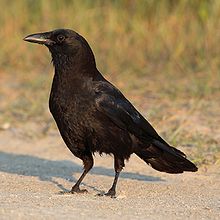Corvus (biology)
| Crow Temporal range: 17–0 Ma Middle Miocene – Recent |
|
|---|---|
 |
|
| American crow (Corvus brachyrhynchos) | |
| Scientific classification | |
| Kingdom: | Animalia |
| Phylum: | Chordata |
| Class: | Aves |
| Order: | Passeriformes |
| Family: | Corvidae |
| Genus: |
Corvus Linnaeus, 1758 |
| Species | |
| many, see | |
| Diversity | |
| c. 45 species | |
Corvus is a widely distributed genus of medium-sized to large birds in the family Corvidae. The genus includes species commonly known as crows, ravens, rooks and jackdaws; there is no consistent distinction between "crows" and "ravens", and these appellations have been assigned to different species chiefly on the basis of their size, crows generally being smaller than ravens. In Europe, the word "crow" is used to refer to the carrion crow or the hooded crow, while in North America, it is used for the American crow, fish crow, or the northwestern crow.
Ranging in size from the relatively small pigeon-sized jackdaws (Eurasian and Daurian) to the common raven of the Holarctic region and thick-billed raven of the highlands of Ethiopia, the 45 or so members of this genus occur on all temperate continents except South America, and several islands. The crow genus makes up a third of the species in the family Corvidae. The members appear to have evolved in Asia from the corvid stock, which had evolved in Australia. The collective name for a group of crows is a 'flock' or a 'murder'. The genus name is Latin for "raven".
Recent research has found some crow species capable of not only tool use, but also tool construction. Crows are now considered to be among the world's most intelligent animals with an encephalization quotient equal to that of many non-human primates.
...
Wikipedia
